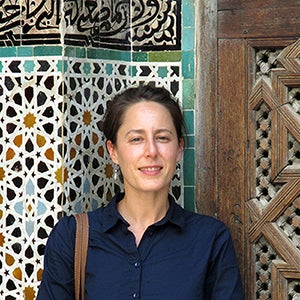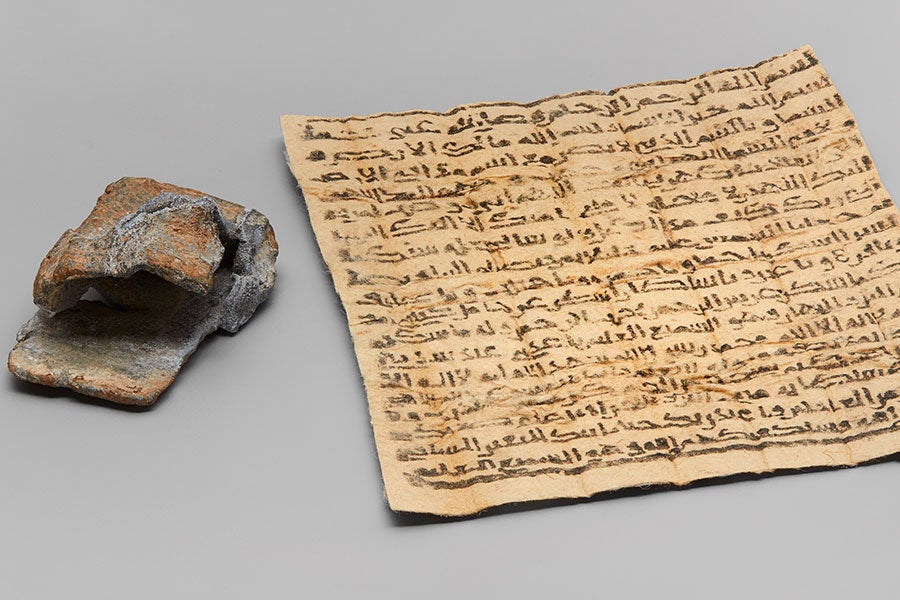Two Islamic Amulets in the Aga Khan Museum:
Inked Surfaces, Hidden Stories
Christiane Gruber
Synopsis:
Humans have sought protection from pain, harm, and negative forces since time immemorial. In Muslim lands, invocations to God and verses from the Qur’an are believed to be especially protective, and so appear on various objects over the centuries. Discover two such amulets held in the Aga Khan Museum that were made to safeguard their owners and wearers: a tiny 11th-century Egyptian printed sheet of paper and a large 19th-century Iranian talismanic chart inked on gazelle skin. Their Arabic-script written and geometric contents also appear on coins, arms and armor, and talismanic shirts, revealing a larger material urge to bring spiritual blessings in close proximity to—and, at times, even absorption into—the physical body.
Online Resources:
Printed Amulet with Box, Aga Khan Museum, AKM508.
Talismanic Chart, Aga Khan Museum, AKM536.
Hidden Stories: Books Along the Silk Roads, digital exhibition.
Christiane Gruber. “The Arts of Protection and Healing in Islam”: “Essay 1: Amulets and the Body,”; “Essay 2: Water Infused with Blessing,”; and “Essay 3: Talismanic Shirts as Premodern PPE.”
Yasmine Al-Saleh. “Amulets and Talismans from the Islamic World.”
Related Khamseen Presentations:
Sabiha Göloğlu, “Touching Mecca & Medina: The Dalā’il al-Khayrāt and Devotional Practices,” Khamseen: Islamic Art History Online, published 28 August 2020.
Rachel Parikh, “Talisman,” Khamseen: Islamic Art History Online, published 3 September 2021.
Eszter Spät, “The Nîshans of the Yezidis of Northern Iraq,” Khamseen: Islamic Art History Online, published 13 May 2021.
References:
Leoni, Francesca, ed. Power and Protection: Islamic Art and the Supernatural. Oxford: Ashmolean Museum, 2016. ![]()
Porter, Venetia, Liana Saif, and Emilie Savage-Smith. “Medieval Islamic Amulets, Talismans, and Magic.” In A Companion to Islamic Art and Architecture, ed. Finbarr Barry Flood and Gülru Necipoğlu (Hoboken: Wiley & Sons, 2017), vol. 1, 521–557. ![]()
Saif, Liana et al. Islamicate Occult Sciences in Theory and Practice. Leiden: Brill, 2020. ![]()
Savage-Smith, Emilie, Ralph Pinder-Wilson, and Tim Stanley. Science, Tools & Magic. The Nasser D. Khalili Collection of Islamic Art, vol. 12. London: The Nour Foundation in association with Azimuth Editions and Oxford University Press, 1997. ![]()
Schaefer, Karl. Enigmatic Charms: Medieval Arabic Block Printed Amulets in American and European Libraries and Museums. Leiden: Brill, 2006. ![]()
Worksheet:
A worksheet for this video is available here.
Also visit the Khamseen Worksheets page here.
Citation:
Christiane Gruber, “Two Islamic Amulets in the Aga Khan Museum: Inked Surfaces, Hidden Stories,” Khamseen: Islamic Art History Online, published 10 February 2022.

Christiane Gruber is Professor of Islamic Art and Former Chair in the History of Art Department at the University of Michigan as well as Founding Director of Khamseen: Islamic Art History Online. Her scholarly work (available here) explores medieval to contemporary Islamic art, including figural representation, depictions of the Prophet Muhammad, manuscripts and book arts, architecture, and modern visual and material cultures. Her two most recent publications include The Praiseworthy One: The Prophet Muhammad in Islamic Texts and Images and The Image Debate: Figural Representation in Islam and Across the World, and her public-facing essays have appeared in Newsweek, The Conversation, New Lines, Jadaliyya, and Prospect Magazine, among others. Her current research projects include eco-Islamic art and architecture as well as the visual culture of the Nation of Islam.


